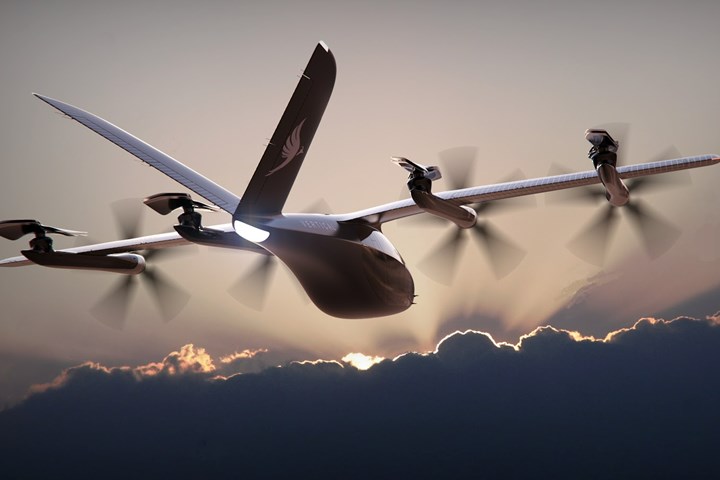Vertical Aerospace partners with GKN Aerospace on wing structure for VA-X4 eVTOL
GKN will deliver wing structures and wiring systems for the composites-intensive, zero-emissions aircraft.

A rendering of the VA-X4. Photo Credit: Vertical Aerospace
On Sept. 17, electric vertical takeoff and landing (eVTOL) vehicle manufacturer Vertical Aerospace (Bristol, U.K.) announced a developed and production agreement with GKN Aerospace (Redditch, U.K.) for the wing structures and wiring system on Vertical’s aircraft. The zero-emissions VA-X4 is said to have a carbon fiber composite airframe and custom-designed wings.
Vertical plans to benefit from GKN Aerospace’s experience in aerostructures design and manufacture for leading commercial and defense aircraft, track record with safety and certification and 41 manufacturing locations across 13 countries. GKN Aerospace’s wing structures and wiring are expected to lead to a VA-X4 aircraft with higher performance; lower manufacturing costs, weight and emissions; a secure path to certification; global production; and shorter production times and lower unit costs.
GKN Aerospace joins Vertical’s ecosystem of partners including Solvay (Brussels, Belgium), Rolls-Royce (London, U.K.), Honeywell (Phoenix, Ariz., U.S.) and Microsoft (Redmond, Wash., U.S.).
Stephen Fitzpatrick, founder and CEO at Vertical, says, “We are delighted that [GKN Aerospace is] joining our unrivalled partner ecosystem. Their expertise in producing aerospace systems and structures will help the VA-X4 to meet the stringent safety standards mandated by the CAA and EASA, an essential step forward in our efforts to electrify flight.”
John Pritchard, president of GKN Aerospace’s Civil business, says, “The rapid progress being made towards electric aircraft is a game-changer for the industry. GKN Aerospace has decades of experience as a leader in both aerostructures and EWIS and we are excited to use that expertise to accelerate the transition to more sustainable aviation. Vertical has a great vision and we are proud that our technology can help bring that to reality and shape the future of flight.”
Related Content
-
Beta begins Alia CTOL production aircraft flight testing
Flight of first production aircraft fresh off Beta’s full-scale manufacturing line in Vermont is followed by Special Airworthiness certification from the FAA.
-
Joby flies two eVTOL aircraft simultaneously in testing milestone
The latest in the company’s flight testing program targets certification testing acceleration and support of its passenger-carrying goals by 2026.
-
Midnight production aircraft completes full transition flight
This is Archer’s second full-scale eVTOL aircraft to achieve this milestone, critical to being able to carry commercially viable passenger payloads.
.jpg;width=70;height=70;mode=crop)





